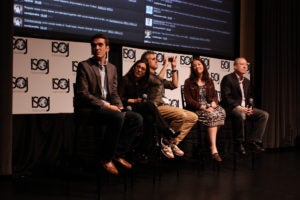April 21, 2012 | Featured, Innovation, Social Media
Optimizing News Through Social Media Rather Than Feeding the Search Engine

Friends and followers: Unite and write!
Social media is becoming a major player in the field of journalism. Representatives from all around the digital news realm spoke in a panel at ISOJ 2012 that discussed a prevailing wind bringing us from SEO (search engine optimization) to SMO (social media optimization).
Reporters and editors have often built their online news structure to appease search engine giants like Google. But with the rise of social media like Twitter and Facebook, the new giant is becoming a collection of our friends and followers.
Carmen Cano, digital managing editor for The Dallas Morning News, began the panel by helping us understand what exactly these acronyms mean for us. According to her, it’s widely understood amongst newsrooms that SEO is all about content, keywords and links.
“In many ways, we pay attention to SEO out of fear,” Cano said.
However, Cano insisted that these buzzwords like “SEO” and “SMO” get in the way of being “genuine” on a social media platform. But nevertheless, she presented us with a new acronym: SEE. It stands for the concept that Social/Search/Semantic must give the audience an Excellent Experience.
“I never paid attention to SEO, never in my life,” admitted Borja Echevarria, deputy editor for El País, adding that Google News doesn’t have as big of affect in Spain as it does in the United States
But social media is a top priority for El País. The Spanish newspaper has already created its own social network in order to track information about their users.
Echevarria discussed both the good and bad of intense social engagement. El Paísfaced an issue with a 2005 article sneaking it’s way into the most viewed charts during a more recent election. This problem, which a writer with El País dubbed “The Lazarus Effect,” is just a side-effect that must be accepted as part of a news organization’s use of social media.
Jen Lee Reeves, interactive director of KOMU-TV and associate professor at the Missouri School of Journalism, discussed the structure of her student-run KOMU-TV newsroom and how she expects news-worthy content from her students via Twitter so they can learn how to deliver through this platform “naturally.”
Reeves believes that innovation is where it’s at. No one has been able to blend traditional reporting with social media completely. She even admitted that her newsroom has faced a problem with too much social media.
During her presentation, Cano gave statistics about what happens in only one second across the social media spectrum, with posts and updates ranging in the thousands. Those numbers speak volumes. As more people begin participating in online media, the more social it will become.
The moral of today’s panel: Now is the time to engage with your friends, followers and feeds.
ISOJ 2012: SEO to SMO Question & Answer, from Knight Center on Vimeo.

